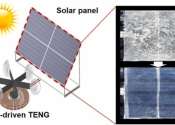Increasing the efficiency of eco-friendly solar cells by converting wind energy into high-voltage electricity
A research team led by Professor Lee Ju-hyuck of DGIST in the Department of Energy Science & Engineering has successfully developed an energy harvesting device that enhances solar energy efficiency by removing and preventing ...
Mar 29, 2024
0
54









